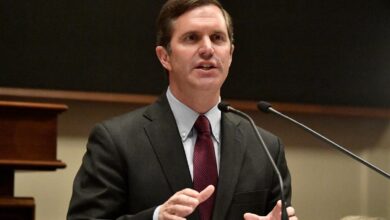How Formula 1 cracked America

The setting is the Indianapolis Motor Speedway: home to the world-famous Indy 500 race. Ahead of the 2005 United States Grand Prix, at a circuit modified for Formula 1, ITV pundit and former F1 driver Martin Brundle is interviewing the sport’s long-term supremo and commander-in-chief Bernie Ecclestone on the grid. And you may well say, nothing unusual about that.
What is more unusual is Brundle’s direct, bordering on combative, line of questioning. A huddle of camera crew and journalists huddle around, eager for answers. Because F1’s only race in the land of the free is about to become a farce. Out of 20 cars, only six take to the start line. For the sport and its tempestuous 55-year relationship with the US, it is the ultimate moment of absurdity. “The future of Formula 1 in America?” asks Brundle. “Not good,” Ecclestone replies.
It is a far cry from where the sport is stateside now. Formula 1 is pushing boundaries and breaking the glass ceiling in a manner which would be unambiguously imposing if it wasn’t in the United States. There are now three races, with this week’s grand prix on the Las Vegas strip following on from a highly successful rebirth of the US Grand Prix in Austin and a street track in Miami.
After 75 races at 11 different American venues, F1 has finally cracked the American code.
“At my kids’ soccer game, you’ll see someone with a Red Bull shirt on,” says Scott Speed, a Californian native who raced in F1 for two years in the 2000s. “It’s been a long time coming but there is a noticeable difference when you see people walk around in F1 apparel. That’s very different to when I was in the sport.”
But sometimes to understand the scale of the current highs, you have to revisit the lows of yesteryear. That ludicrous weekend in Indianapolis 18 years ago was, in his own words, a “super huge” weekend for Speed.
He was testing for Red Bull at his home race, a week on from his first F1 test in Canada, but his team along with six others would not be racing come Sunday. Fourteen of the cars were using Michelin tyres which had resulted in several tyre failures in practice and qualifying at the final corner, including a heavy shunt for Toyota’s Ralf Schumacher, due to the abrasive nature of the high-speed banked turn.
Installing a chicane to reduce speeds was suggested and rejected on the grounds that it would be unfair to the Bridgestone tyre runners – which included Michael Schumacher’s Ferrari team. Unable to take the risk of a serious accident, all Michelin cars did not start the 73-lap race. Schumacher won the six-car race to a chorus of boos in the grandstands.
“The penalty if you went off there [turn 13] was just too hot, it was a big shunt,” Speed recalls. “I remember in my meeting with the engineers, they said ‘your tyre was two laps from blowing up as well.’ That was a really surreal feeling and then I had a big feeling of relief. It was very scary knowing I’d have been in the same situation that Ralf [Schumacher] was in.”
F1 did race in Indiana again, fulfilling its contract for two more years. But Lewis Hamilton’s win in 2007 was F1’s last venture at a track simply inadequate for both the basics and spectacle of the sport. One of F1’s lowest moments had been the catalyst for a period of nonexistence, with the sport undergoing a four-year period of inactivity across the Atlantic.
Brundle closed that Ecclestone episode with one of his most famous lines. Trundling over to speak to the chief’s then-wife Slavica, he asks: “Mrs Ecclestone, this needs a women’s intuition on this don’t you think?” She refuses to comment.
“I think you should have something to say,” quips Brundle. “And give him a jolly good slapping.”
***
There have been years of ingenuity, dissatisfaction and scandal ever since the United States first hosted a race in Formula 1 in the sport’s inaugural year in 1950. Back then, the Indy 500 was classed as a championship race. In the decades since, Ecclestone and his team of millionaire race-makers had flirted ferociously with the American market – a crowded field of ultra-popular US sports, college competition and their own brand of motorsport with Indy Car and NASCAR.
But the first signs of a rebirth after the Indiana farce came just over a decade ago. The composition and creation of the Circuit of the Americas (COTA) in Austin, Texas, gave F1 a lifeline in the United States.
It was a low moment for F1 and the sport’s supremo Bernie Ecclestone (right)
“They finally got their location right,” Speed tells The Independent. “Austin is a booming demographic, it’s like having a grand prix in New York. You’re in close proximity to a lot of fans and they’ve built a fantastic racetrack. That helps a lot, it’s a really special circuit.”
But it was still merely a foothold; hardly the stamp it craved. A proposed race in New York, with the Manhattan skyline and Hudson River in the backdrop, was crafted and discarded. COTA’s attendance of 265,000 at the inaugural race in 2012 dropped consistently to 224,000 by 2015.
But Ecclestone’s 40-year stranglehold on the sport was loosening. New suitors showed their hand and Liberty Media – the world’s biggest sports media company – completed an $8bn takeover in January 2017.
What followed was a revolutionary revamp of Formula 1, its leaders and, most significantly, its output. Liberty took full control, revitalising the sport’s social media output and relaxing out-of-date restrictions on teams publishing their own content. The immediate target demographic was young people and expanding the audience beyond its traditional European borders. But they still lacked a crown jewel.
The remaining 14 cars – using unsafe Michelin tyres – entered the pits
Scott Speed raced in Formula 1 for two years in the 2000s





